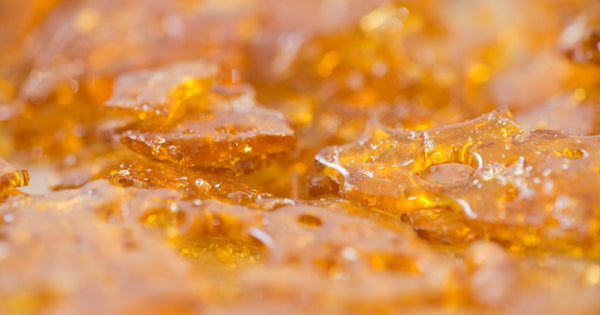How Is Shatter Made?
Jul 17, 2023
Shatter, a type of cannabis concentrate known for its translucent, amber-like aesthetics, and high potency, is one of the most popular methods of consuming cannabis.
Its glass-like structure, which can shatter like brittle candy, and its high THC content, offering a powerful, fast-acting experience, make it a sought-after choice for many cannabis connoisseurs. But have you ever wondered how these cannabis extracts are made?
This guide on producing shatter serves as an educational overview, designed to showcase the tools used to make shatter on a commercial level and the step-by-step process of transforming raw plant matter into a golden and clear extract.
What Is Shatter?

Shatter weed is a type of butane hash oil (BHO) cannabis concentrate, named for its translucent, glass-like appearance that shatters upon impact, much like a piece of hard candy might.
This cannabis extract can range in color from a light honey hue to a darker amber, depending on various factors like the strain of cannabis used and the purification process.
The primary allure of marijuana shatter lies in its potency. It's a highly concentrated form of cannabis, often boasting a THCa content of 60% to 80%. This means that even a tiny amount can have a profound effect, delivering an intense and immediate high for medical marijuana patients and recreational users alike.
However, due to this high THC concentration, shatter is incredibly potent, and it’s not typically recommended for novice cannabis users or those with a low tolerance. Furthermore, the high levels of THC in shatter could potentially lead to severe withdrawal symptoms if used heavily over time and then abruptly stopped.
The process of making shatter involves extracting the cannabinoids and terpenes from cannabis plants using solvents, particularly light hydrocarbons (i.e. butane and propane). This process results in a sticky oil that undergoes further refinement, which includes purging out the residual solvent and a winterization process to remove unwanted elements such as fats and waxes. The final result is a beautiful, glass-like slab of concentrated cannabis goodness.
Materials and Equipment
Creating shatter in a commercial setting is an intricate process that requires professional-grade tools and materials. Here's a list of what processors use during the extraction process, each with a brief description and explanation of its role in the process.
Remember, the process of making shatter is complex and requires a clear understanding of chemistry and safety precautions. Commercial production should always adhere to local laws and regulations, including obtaining necessary permits and licenses. It's also important to have a quality assurance process in place to ensure the safety and consistency of the final product.
Cannabis Extraction
Creating shatter on a commercial scale involves a complex extraction process using professional-grade equipment. The process requires precision and expertise in order to ensure safe and efficient production. Let's walk through the steps involved:
Solvent-Based Extraction
The cannabis plant matter (i.e. cannabis flowers and trim) is loaded into a closed-loop extraction system, which uses a high-purity solvent (usually butane or propane) to strip the cannabinoids and terpenes from the plant material. The solvent and cannabis mixture is then collected in a separate chamber.
Recovery of Solvent
The next step is to recover the solvent from the mixture. In a closed-loop system, the solvent is evaporated and then re-condensed in a recovery tank, leaving behind the crude cannabis oil. The benefit of a closed-loop system is that it recycles the solvent for future extractions, making the process more efficient and environmentally friendly.
Purging

Post-processing is crucial in the creation of shatter, especially in a commercial setting. These filtration processes are essential for removing undesired compounds and residues, ensuring the final product is both safe and high-quality.
Purging is a process designed to remove the residual solvents left over from the extraction process. In the case of shatter, this usually refers to butane or propane. Here's how it works in a commercial context:
- The raw cannabis oil, still containing some solvent, is spread thinly on a silicone or PTFE mat and placed into a vacuum oven.
- The oven applies low heat (usually around 90-110°F) which helps to lower the boiling point of the solvent.
- The vacuum oven also lowers the atmospheric pressure around the oil, further reducing the boiling point of the solvent and allowing it to evaporate off more easily.
- This purge process can take anywhere from a few hours to a full day, depending on the volume of oil and the equipment used. The goal is to remove as much of the solvent as possible without affecting the cannabinoids and terpenes.
Storing Shatter

Storing shatter properly is crucial to maintain its potency, flavor, and overall quality. Incorrect storage can lead to degradation of the product over time. Here are some guidelines for optimal storage conditions for cannabis concentrates:
Achieving Excellence in Shatter Production
The process of creating cannabis concentrates like shatter, while complex, is achievable with the right knowledge, precision, and professional-grade equipment. Each step of the process, from extraction to purging, is a crucial component in the creation of shatter. It's these careful, calculated processes that ensure the production of a safe, potent, and flavorful product.
The most important aspects are quality control, safety, and adherence to local laws and regulations. With these in mind, commercial facilities can create shatter that provides an exceptional experience for consumers, contributing to the growing legacy of this remarkable concentrate.
Filter Media Sample Request
Interested in trying our filter media? We would love to send you some! Browse our products, then fill out this form and someone from our team will be in touch to finalize your request.







